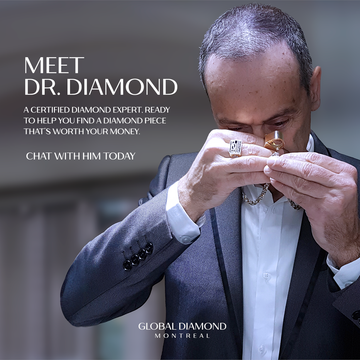When most people think of lab-grown diamonds, they often also think about the word ‘fake’. But what exactly are lab-grown diamonds, and why are they not considered fake? Today, we'll look into the world of lab-grown diamonds to understand their true value and dispel these misconceptions.
Are Lab-Grown Diamonds Real?
Lab-grown diamonds, also known as synthetic diamonds or cultured diamonds, are real diamonds that are created in a laboratory setting. These diamonds possess the same physical, chemical, and optical properties as natural diamonds. The process of creating lab-grown diamonds involves replicating the natural conditions under which diamonds form in the earth’s mantle.
How Lab-Created Diamonds Are Made
There are two primary methods used to create lab-grown diamonds: High-Pressure, High Temperature (HPHT) and Chemical Vapor Deposition (CVD).
High-Pressure High Temperature (HPHT):
This method mimics the natural process of diamond formation by subjecting carbon to high pressure and high temperature. A small diamond seed is placed in a carbon source and exposed to extreme conditions, causing carbon atoms to crystallize around the seed, forming a larger diamond.
Chemical Vapor Deposition (CVD):
In this method, a diamond seed is placed in a chamber filled with carbon-rich gas, such as methane. The gas is ionized into plasma, breaking down the carbon molecules. These molecules then deposit onto the diamond seed, layer by layer, forming a diamond crystal.
Both methods result in diamonds that are identical to natural diamonds in every measurable way.
Lab-Grown Diamonds vs. Natural Diamond Simulants
Lab-grown diamonds are often misunderstood and mistakenly compared to diamond simulants like cubic zirconia (CZ) and moissanite. However, it is crucial to distinguish between these substances.
Cubic Zirconia (CZ):
CZ is a synthetic material that looks similar to diamonds but is composed of zirconium dioxide. It is much softer than diamonds and lacks the same brilliance and durability.
Moissanite:
Moissanite is a naturally occurring mineral, silicon carbide, which can also be created synthetically. It is known for its exceptional brilliance and hardness but differs chemically from diamonds.
Unlike CZ and moissanite, lab-grown diamonds are pure carbon crystals, just like mined diamonds. They exhibit the same hardness, brilliance, and sparkle that have made diamonds highly sought after.
Why Lab-Grown Diamonds Are Not Fake
The term "fake" is often used to refer to something that is not genuine or authentic. Lab-grown diamonds do not fit this description for several reasons:
Composition:
Lab-grown diamonds are composed of carbon atoms arranged in a crystal lattice structure, identical to natural diamonds. This composition gives them the same physical properties, including hardness and thermal conductivity.
Properties:
Lab-grown diamonds are graded and certified using the same criteria as natural diamonds, including the famous 4 Cs: Cut, Color, Clarity, and Carat. They can achieve the same grades and quality levels as their natural counterparts.
Visual Appeal:
To the naked eye, and even under magnification, lab-grown diamonds are indistinguishable from natural diamonds. They exhibit the same brilliance, fire, and scintillation that make diamonds so captivating.
Environmental and Ethical Considerations
One of the most compelling reasons to choose lab-grown diamonds is their environmental and ethical advantages. Traditional diamond mining has significant ecological impacts, including habitat destruction, soil erosion, and water pollution. Additionally, the mining industry has been plagued by issues such as conflict diamonds, which are mined in war zones and sold to finance armed conflict against governments.
Lab-grown diamonds offer a more sustainable and ethical alternative. They require fewer resources and result in less environmental degradation. Moreover, they are free from the ethical concerns associated with conflict diamonds, providing consumers with peace of mind.
Economic Benefits
Lab-grown diamonds are typically more affordable than their mined counterparts. The cost savings come from the shorter supply chain and the ability to produce diamonds in a controlled environment. This price difference allows consumers to purchase larger or higher-quality diamonds for the same budget, making luxury more accessible without compromising on quality or ethics.
Common Misconceptions
Several misconceptions about lab-grown diamonds persist, often leading to confusion among consumers. Let's address some of these myths:
Lab-Grown Diamonds Are Not Real:
As established, lab-grown diamonds are chemically, physically, and visually identical to natural diamonds. They are not imitations or fakes but real diamonds grown in a lab.
Lab-Grown Diamonds Are Flawed:
Just like natural diamonds, lab-grown diamonds come in various qualities and grades. They can be flawless or contain inclusions, and their quality is assessed using the same standards as natural diamonds.
Lab-Grown Diamonds Have No Resale Value:
While the resale market for lab-grown diamonds is still developing, their value is recognized in the industry. As consumer awareness and acceptance grow, the resale value of lab-grown diamonds is expected to stabilize.
Shop Certified Lab Grown Diamonds
When choosing between a lab-grown diamond and a mined diamond, it ultimately comes down to personal preference and values. Both options are stunningly beautiful and durable, but lab-grown diamonds provide additional benefits such as environmental sustainability, ethical assurance, and cost-effectiveness.
If you value cutting-edge technology, eco-friendly practices, and ethical sourcing, lab-grown diamonds are an excellent choice. They are the future of the diamond industry, offering a modern alternative that aligns with contemporary values.
At Global Diamond Montreal, we are proud to offer a selection of exquisite lab-grown diamonds, ensuring you can make a choice that reflects both your taste and your values.
Explore our collection today and discover the brilliance of lab-grown diamonds for yourself. Whether for an engagement ring, a special gift, or a personal treat, lab-grown diamonds provide a dazzling option that does not compromise on quality or conscience.

 Fiançailles
Fiançailles Bagues Solitaires
Bagues Solitaires Anneaux de halo
Anneaux de halo Anneaux d'anniversaire
Anneaux d'anniversaire Bagues en diamant noir
Bagues en diamant noir Bagues avec pierres précieuses
Bagues avec pierres précieuses Anneaux de cocktail
Anneaux de cocktail Porte-clés grecs
Porte-clés grecs Trinity Rings
Trinity Rings Oval Rings
Oval Rings Mariage
Mariage Anneaux d'éternité
Anneaux d'éternité Bagues semi-éternité
Bagues semi-éternité Bandes de mariage
Bandes de mariage Boucles d'oreille en diamant
Boucles d'oreille en diamant
 Boucles d'oreilles en pierres précieuses
Boucles d'oreilles en pierres précieuses
 Gold Earrings
Gold Earrings
 colliers et pendentifs
colliers et pendentifs Colliers en or
Colliers en or
 Colliers de diamants
Colliers de diamants
 Colliers de pierres précieuses
Colliers de pierres précieuses
 Bracelets
Bracelets Bracelets en diamant
Bracelets en diamant
 Bracelets de pierres précieuses
Bracelets de pierres précieuses
 Pour hommes
Pour hommes Men's Diamond Bracelets
Men's Diamond Bracelets Chaînes en or
Chaînes en or Men's Pendants
Men's Pendants Men's Gold Bracelets
Men's Gold Bracelets




